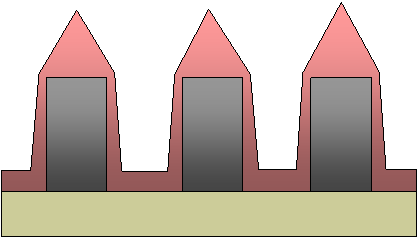 |
|
PECVD - plasma enhanced CVD
- Characteristics:
- It was created in order to deposit at low temperature
- Thermal energy required for reactions, diffusion, etc is replaced with plasma energy
- The gases are dissociated in the gas phase by collisions with high-energy electrons (accelerated by the applied bias)
- The rest of the processes are similar to CVD, only the dissociation processes are different; also the ionisation/excitation processes occur and ions bombard the film surface
- Advantages:
- Low temperature applications
- Energy for reactions is provided by plasma particles
- Better step coverage due to energetic bombardment
- Disadvantages:
- Uniformity - plasma nonuniformities are reflected in film nonuniformities (the layer is usually thicker in the centre of the wafer)
- Throughput - usually in the PECVD reactors the wafers are horizontally placed, thus the throughput is much lower than in the case of LPCVD
- Damage - the ions can sputter the deposited film, a remote plasma is used for a lower damage (substrate is not placed inside the plasma, but at a distance from the plasma and the radicals diffuse toward the substrate)
- Applications: passivation, ILD - dielectric between metal lines, gate dielectric in TFTs, when deposition is done on substrates that cannot withstand high temperature such as glass, plastic, metal
- HDP - high density plasma (ECR or ICP)
- high density of electrons
- created usually at low pressure
- is used to obtain Si3N4 with better film properties from N2
- disadvantage = lower deposition rate than PECVD
- Ion bombardment at low pressure etches the excess material found at the corners of the structure(overhang), improving the step coverage
- Too much bombardment however can produce structures with triangular shape, like in the picture below
 |
|
